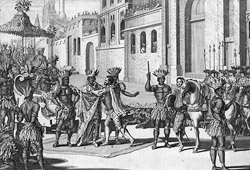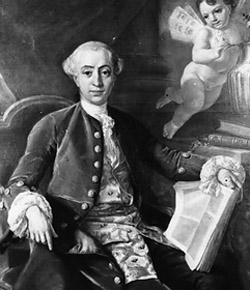history proves what we already knew: chocolate is good and chocolate is good FOR you!
Story by Kathryn R. Burke
All content © San Juan Publishing Group, Inc, All rights reserved.
MONTEZUMA, SOCRETES, CASANOVA, Queen Isabella, Dominican Friars, Louis XIV, Madame Pompadour, Johann Wolfgang von Goethe, Queen Victoria, Rodolphe Lindt, General Eisenhower, Niel Armstrong — what do these people have in common? They all LOVED chocolate.
Few foods evoke as much passion as chocolate. Myriad historical references to folklore and history from many cultures claim consuming chocolate instills faith, improves health, builds strength, and fuels sexual passion. Once an indulgence of royalty, chocolate is now a treasured and accessible – and yes, even healthy – treat.
 History of Chocolate
History of Chocolate
The Greeks called it “theobroma” or “food of the Gods,” naming it from the seeds from the tropical Theobroma cacao tree.
The Maya, who have used it for more than 3000 years, called it “xocolati,” or bitter water, a name which suggests they made a drink of it. (Sugar was unknown in the Meso-American cultures.)The Aztecs believed their god, Quetzalcoatl, descended from heaven carrying a cocoa tree. Both Amazon cultures believed chocolate to be a source of wisdom and vitality, reserving it’s use for noblemen, priests, and warriors. Records dating to 1200 AD (and before) show cocoa beans were used also as a form of currency. Making use of its many qualities, the Emperor Montezuma purportedly drank 50 (golden) goblets of chocolate a day, which would have made him wealthy and wise and a very busy boy, especially when it came to the ladies.
Chocolate has long been valued for its aphrodisiac qualities. This attribute was later enjoyed by many, including the famous philanderer Casanova as well as multitudes of aspiring lovers today who celebrate Valentine’s Day (the day of lovers) with gifts of chocolate. Kind of a foppy looking fellow, wasn’t he, for all his licencious reputation.
Chris Columbus, and to a greater extent, the Spanish priests, brought the heady stuff to Europe, the first major shipment of it arriving in Spain in 1585. As it was in the new world, it soon became a substance reserved for nobility. The kings and their kinsmen (and ladies) knew a good thing when they saw it, and saw no need to share it with the common folk. (For several humorous anecdotes of chocolate’s arrival in Spain, including mistaking it for sheep dung and Catholic condemnation of the drink, check here.)
Except, where the Colombian cultures consumed it with vanilla, chile pepper, and achiote, the Europeans preferred milk and sugar and made sweet drinks out of it. Both groups enjoyed the somewhat psychotic benefits of fermenting it, however. Perhaps the term “chocoholic’ (defined by Webster as a chocolate addict) dates back to the Mayans? Although Montezuma and his buddies knew it to be an aphrodisiac, chocolate’s rep really grew when the French got a hold of it. Madame de Pompadour gave it a go, but became discouraged when it failed to stimulate the amorous interest of Louis XVI, but her contemporary Madame du Barry, a nymphomaniac, found it quite handy. Chocolate is, after all, reputed to increase vitality. You might call it a 16th century Viagra? At the very least, its proponents could have been called “chocoholic,” an actual term for a chocolate addict as defined by Webster.
They could also have been called fat, for chocolate addicts were well on their way to that dubious destination. By the 1800s, chocolate was an expensive European confection and import, a sign of wealth and distinction as it evolved into deserts and candies, which had less cocoa and more sugar. And fat. The scales started to tip. In the wrong direction. The Swiss, and later the Belgians, took the lead in chocolate production. The English soon got into the game, developing the first modern chocolate bar (Joseph fry, 1847) then the Cadbury brothers two years later. In 1874, Daniel Peter and Henri Nestle added condensed milk and made a popular, creamy milk chocolate drink, one still marketed today. In 1879 another Swiss, Randolphe Lindt, figured out how to make soft chocolate by adding triglycerides in the form of cocoa butter. In the early 1900s, Frank Mars and his family invented the Snickers, Milky Way, Three Musketeers, and Mar’s Bars. In 1913 Jules Sechaud of Montereux Switzerland introduced filled chocolates. During the Spanish Civil War, observing soldiers eating sugar-coated chocolate, his son was inspired to invent M&Ms. Chocolate soon became a ration for all soldiers, even those going into space. It has been in recent years by the astronauts.
Whew! Bet that’s more than you need to digest to ingest some chocolate!
 Besides having substantial aphrodisiac qualities, well-noted by Montezuma and the infamous Cassanova (who used it as an early form of Viagra), chocolate also has proven heart-healthy properties.
Besides having substantial aphrodisiac qualities, well-noted by Montezuma and the infamous Cassanova (who used it as an early form of Viagra), chocolate also has proven heart-healthy properties.
Magical Health Properties
So what makes chocolate so special? Yes, it’s an aphrodisiac and makes you feel good attribute that to endorphins, a substance produced by the pituitary gland during orgasm, exercise, and consumption of certain foods including chocolate. No wonder chocolate is the food for lovers. Yes, consuming it gives you a lift, “instant” energy— cacao beans, chocolate’s source, are rich in stimulants like caffeine and theobrimine (remember the Greek word for Chocolate?). Both of these substances help combat fatigue. Which is why soldiers use it in battle, hikers like in their trail mix, skiers drink it after a couple of good runs. But it can do so much more than make you feel good. Chocolate is good for you! It’s a flavonoid, a natural antioxidant. This naturally-occurring substance helps shield you from environmental toxins, relaxes blood vessels (the theobrimine again), and “may positively affect the balance of certain hormone=like compounds … thought to play a role in cardiovascular health.” What kind of chocolate you consume is important. Dark chocolate, (70% cacao or better) has the highest amount of flavonoids.
According to an Aug. 2009 article on “Discovery News”: “Heart attack survivors who eat chocolate two or more times per week cut their risk of dying from heart disease about threefold compared to those who never touch the stuff.” Earlier studies had already proven chocolate can lower blood pressure and cut the “rate of heart-related mortality in healthy older men, along with post-menopausal women.” An article on WebMD also suggests that eating dark chocolate (not white or milk chocolate) can lower blood pressure. (c) and touts its properties as a natural antioxidant. Consumed moderately as part of a healthy lifestyle, it may also “improve blood sugar and insulin sensitivity, reducing diabetes risk.”
Numerous studies show substances high in phytochemicals, such as cacao, produce antioxidants, which may help prevent cancer and and heart disease. Cancer-preventive properties include combinations of beta-carotene, vitamin E, and selenium. Fatty buildup in the arteries (oxidation of low-density lipoprotien cholsesterol, known as the “bad” LDL can cause, heart disease. Eating foods rich in antioxidants reduces both risks. Don’t forget to eat other flavonoid-rich foods like apples, red wine, tea, onions and cranberries. Chocolate isn’t the only good health food, but it’s mighty tasty!
But, what about the fat, you ask? Well, maybe it’s not so bad. According to the Cleveland Clinic article, the fat in chocolate is about half oleic acid, (hearth-healthy monounsaturated fat also found in olive oil) and half stearic and palmitic acids (saturated fat which is not good for you). Recent research, however, seems to negate that, or at least some of it, and in any case, the darker, the chocolate, the better it is for you. And the purer the better. It’s the stuff stuffed in the chocolate that causes fat issues, the buttery, “milky” fillings. Although more research in this area is needed to determine just how much chocolate we chocolate-lovers can eat in order to acquire cardioprotective benefits, meantime you can enjoy chocolate in moderate portions a few times per week.
A recent study published in The American Journal of Clinical Nutrition, recommends a daily dose of cocoa powder beverage and dark chocolate will reduce “bad” cholesterol, LDL. Avoid “milk’ chocolate products or those processed with alkali, which is an ingredient of most chocolate products and is not good for you.
OK, then, so eating (dark) chocloate (with high cacao and low sugar content) reduces LDL, helps prevent cancer, lowers blood pressure, improves brain function, stabalizes blood sugar, increases blood flow to the brain… and, thanks to it’s perceived aphrodisiacal qualities, to other places.
Bottom line? Enjoy a long, healthy,happy life! Eat and drink more dark chocolate. It’s good and it’s good for you!
Images
Top banner. Chocloate confection, cacaso beans, Web MD Dark Chocolate Slideshow. Right, dark chocolate bars, Ridgway Natural Foods.
Explorer Hernan Cortés meets Emperor Montezuma II of Mexico. Web MD Slideshow.
Cassanova Web MD Slideshow.
Notes
Ed.: We did a great deal of research for this article. And found that chocolate is good in any quantity, any time, any place. There’s no law against it, so you can happily OD on chocolate and still drive home safely. Good to know at holiday time. . .
References & Additional Links
HISTORY
The Chocolate site
Chocolate History Time Line
History of Chocolate (Wikipedia)
The Sweet Lure of Chocolate (Exploratorium)
HEALTH BENEFITS (honest!)
The Sweet Truth about Chocolate and your Heart (Cleveland Clinic)
“Top 11 Chocolate Myths“. By Melissa Breyer, Mother Nature Network.
“Another Reason to Eat More Chocolate” (Discovery News)
Endorphins (Wikipedia)
Phytochemicals: info/plants/cacao
Dark Chocolate is a Healthy Choice (Web MD)

